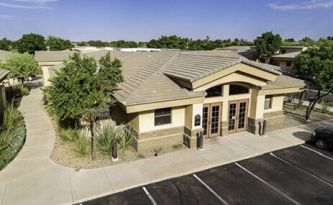Microepididymal and Testicular Sperm Aspiration
Published: 12/11/2015
A certain number of men will not have sperm in the ejaculate. This is known as azoospermia. Semen is present, but on examination no sperm is seen. There are several causes for this to occur. The most common is idiopathic, which probably makes up 90% of the causes of azoospermia, or no identifiable cause for the lack of sperm on ejaculation. These are generally normal males who had normal development of secondary sexual characteristics (pubic hair, muscle mass and shaving), normal adult "maleness" and normal sex drive (libido). The next common cause of a zero sperm count in the semen is known as obstructive azoospermia, which is due to an obstruction of the outflow tract from the testicles to the penis. This can be due to prior surgery on the male genitalia, prior bladder neck surgery, certain infections that can cause scarring, congenital absence of the vas deferens, failed reversals of vasectomy, diabetes, quadriplegia, and retrograde ejaculation (where on orgasm the sperm are ejaculated back into the bladder rather than out through the penis). The other common cause of azoospermia is in a patient that has had a vasectomy. Less common causes of azoospermia is either anabolic steroid or human growth hormone hGH) use, certain medications and either fairly regular alcohol and/or marijuana use.
In normal spermatogenesis, sperm are initially produced in the testicles, in these miniferous tubules, under the stimulation of FSH and LH, from the pituitary, over a period of about 75 days. From there they pass into the epididymis, which are collecting tubules right outside the testicles, where they spend the next 12-26 days undergoing final maturation and where they gain motility and fertilizing ability. In other words, it takes about 3 months or 90+ days to make new sperm. Said another way, sperm a man ejaculates today, he made 3 months ago. Any "event" that happened 3 months prior to doing a sperm count could effect the results of the current SA. Examples would be a sustained high fever, an alcohol binge, heavy marijuana use, certain medications and anabolic steroids and/or human growth hormone use.
Most men with obstructive azoospermia, or no sperm found in the semen on a SA, will have sperm available in the testicles or the epididymis. In the case of idiopathic azoospermia, about 40-50% of men will have sperm found on a testicular biopsy. In the rest of the cases, stopping a particular medication, alcohol, marijuana, steroids or hGH use may restore normal spermatogenesis or at least enable some sperm production to occur. Sometimes there can be enough sperm to get pregnant by intercourse, or at least enough produced to do advanced reproductive technologies like In-Vitro Fertilization (IVF) and Intracytoplasmic Sperm Injection (ICSI).
In cases of azoospermia, sperm can be successfully extracted from the epididymis or testicles by two different methods. The first is known as MESA (microepididymal sperm aspiration), where after numbing the area, a very tiny needle is passed through the scrotum and into the epididymis, and epididymal fluid along with sperm is aspirated out. Epididymal sperm tends to be a bit older sperm and generally has motility (is moving). The other way to obtain sperm is by TESA (testicular sperm aspiration), where again, numbing the scrotum, a very tiny needle is passed into the testicle, and sperm along with a small amount of testicular tissue is aspirated out. The sperm is than separated from the testicular tissue. Testicular sperm is younger sperm and tends not to be moving.
There is an ongoing controversy as to which sperm is better to use- MESA or TESA sperm. An important point is that the sperm that are removed by either MESA/TESA procedures cannot be placed into the uterus or fallopian tubes. The sperm will simply not fertilize normally and more advanced technologies are needed like In-Vitro Fertilization (IVF) and Intracytoplasmic Sperm Injection (ICSI). If given a choice, Arizona Center for Fertility Studies prefers to initially do MESA because eipdidymal sperm tends to be moving and thus making it easier for the embryologist the determine which sperm is "alive".
Of note, just because sperm is not moving does not mean it is not "alive".
Many times, Arizona Center for Fertility Studies has used non-motile sperm for fertilization by Intracytoplasmic Sperm Injection (ICSI) with very good fertilization and pregnancy rates. If with the MESA procedure, no sperm are found then the procedure is switched to TESA, where very often sperm will be able to be located. Even though that sperm will be no motile, the Arizona Center for Fertility Studies embryology laboratory can do certain techniques that can help to stimulate motility and thus make it easier to choose "alive" sperm. Again, as mentioned above, even if the sperm are non-motile that does not mean it will not be successful in fertilization and producing a pregnancy. Also, as mentioned above, any time MESA or TESA is done, In-Vitro Fertilization (IVF) with Intracytoplasmic Sperm Injection (ICSI) will need to be performed because the aspirated sperm will not be able to fertilize on their own and there is never enough to be able to use for standard In-Vitro Fertilization (IVF) (fertilization in the dish), let alone IUI. Arizona Center for Fertility Studies recommends discussing with all men undergoing MESA and/or TESA to cryopreserve the remaining sperm that is not used for Intracytoplasmic Sperm Injection (ICSI), to eliminate the need to have to repeat the procedure in the future.
In all cases of azoospermia, prior to doing a testicular biopsy to check for the presence of sperm to see if IVF-ICSI can be done, the male should have a FSH level drawn. This is done anytime by a simple blood test. FSH is the primary signal from the brain to the testicules responsibile for initiating spermatogenesis or the production of sperm. If the level is greater than 30 IU/ml, it indicates the presence of testicular failure and no production of sperm by the testicles; therefore, a testicular biopsy does not need to be done because no sperm will be found. On the other hand, it the FSH is in the normal or slightly elevated range, than the man should proceed with the testicular biopsy to document the presence of spermatogenesis, or production of sperm, by the testicle. The testicular biopsy is done by a urologist. It is a simple short procedure done in their office where the scrotum is numbed and a very small needle is placed into one or both testicules to obtain a small amount of tissue that is sent to pathology for confirmation of spermatogenesis. If sperm are identified, the couple can proceed with IVF-ICSI, if they decide, in the near future. Even with a normal FSH level, there is no guarantee that sperm will be found on the testicular biopsy. If the FSH is elevated and/or no sperm are found on the testicule, then donor sperm, donor embryos, or adoption are the only options. In a few cases, where the FSH is normal and no sperm is found on a testicular biopsy, Arizona Center for Fertility Studies has placed these men on gonadotropin therapy (HMG and hCG) and occasionally have been able to stimulate the testicles to begin spermatogenesis where sperm are retrieved in the ejaculate or by TESA, as confirmed on a follow-up biopsy.
In the case of a vasectomy, where the tube or vas deferens, leading from the epididymis to the penis has been surgically cut, sperm cannot get out. On ejaculation there are no sperm in the semen. Semen comes from the prostate gland and the seminal vesicles and is not effected by the vasectomy. In cases where a man wants to have future child bearing potential, he has two choices. One is to do a reversal of his vasectomy, the other is to do In-Vitro Fertilization (IVF) and recover sperm from the epididymis (MESA). The advantages of doing a reversal of the vasectomy, known as a vasovasotomy, is that the couple can attempt pregnancy by having intercourse.
The disadvantages of a vasectomy reversal are as follows:
- It is expensive and generally costs around $7,000-$10,000; similar to the cost of a cycle of IVF-ICSI.
- Not all urologists have the same experience and expertise and thus get different results.
- There may not be enough of the vas deferens to put back together because too much was removed at the initial vasectomy.
- Even if the vasectomy reversal is successful and the two ends can be put back together, it can close down or become blocked within 1-2 months after the procedure.
- Even though the surgery is successful and there are sperm in the ejaculate, the quality of those sperm parameters (numbers, motility and morphology)may be so low that neither intercourse or SO-IUI will be successful and the couple will have to do In-Vitro Fertilization (IVF)-Intracytoplasmic Sperm Injection (ICSI) to achieve pregnancy. The poor sperm parameters are generally due to the consequences of a long standing vasectomy. Generally, when the vasectomy was done longer than 9 years ago, although you can get sperm in the ejaculate, overall pregnancy rates are low. Even when the vasectomy was done 2 years ago, the sperm parameters can be extremely low and In-Vitro Fertilization (IVF)-Intracytoplasmic Sperm Injection (ICSI) has to be done to achieve pregnancy. These poor sperm parameters are due to back pressure that develops in the testicle from preventing the sperm from getting out with ejaculation. Even with a vasectomy, the testicles still produces sperm. With no way to get out, pressure builds up in the testicle, damaging the "factories" or semeni feroustubules or cells that produce sperm. In these cases of poor sperm parameters after a vasectomy reversal, Arizona Center for Fertility Studies has found that fertility medications (Clomid),sometimes used to improve spermatogenesis in man with low sperm counts, are generally ineffective and do not improve the sperm parameters because the "factories" that are producing the sperm are damaged and can no longer function properly to produce sperm. However, even though the sperm parameters are poor, the sperm that is available can be very successful in fertilization of an egg when In-Vitro Fertilization (IVF)-Intracytoplasmic Sperm Injection (ICSI) is done, with good pregnancy outcomes.
- As a result of the vasectomy there is a break in the blood-testes barrier and sperm or sperm components can get into the blood stream. Since the immune system has never seen sperm or sperm parts before in the blood, it makes antibodies against these sperm, known as antisperm antibodies, which attach to the sperm. This is generally of no consequence until the man wants future childbearing ability and decides to reverse his vasectomy. Since the ASA are so small they can pass into all parts of the body including the testicules, epididymis and vas deferens. As a result, after a successful vasectomy reversal, and there are sperm in the ejaculate, the ASA can attach and bind to these sperm and immobilize them, so they have no motility and thus cannot fertilize or produce a pregnancy. Arizona Center for Fertility Studies strongly recommends, that before any man has a reversal of his vasectomy, he has his blood drawn to evaluate for ASA. An ASA showing less than 40% of the sperm bound by antibodies is normal and if the man wants to proceed with the reversal instead of In-Vitro Fertilization (IVF), then it is okay. If the ASA shows greater than 40% of the sperm bound by antibodies, and it is not atypical to see 80-90+%bound, then reversing the vasectomy may be successful in sperm production, but most, if not all of the sperm may be non-motile and will not be able to achieve a pregnancy.
- It requires surgery with anesthesia and there can be complications, although uncommon.
Arizona Center for Fertility Studies strongly recommends that before a man decides to have a reversal of his vasectomy that he is given the pros and cons, as well as the risks and complications, finances of the reversal vs. IVF-ICSI and the success rates of each, before the couple makes their decision. Once the couple is aware of the pros and cons of each decision, then they can make the choice that is best for them. Although, vasectomy reversals can be successful in the hands of an experienced urologist; far too often, when it is unsuccessful or the sperm parameters are poor the couple has to be looking at doing IVF-ICSI to achieve a pregnancy, they state, "they were never told of any other options".











